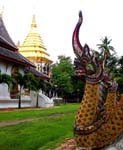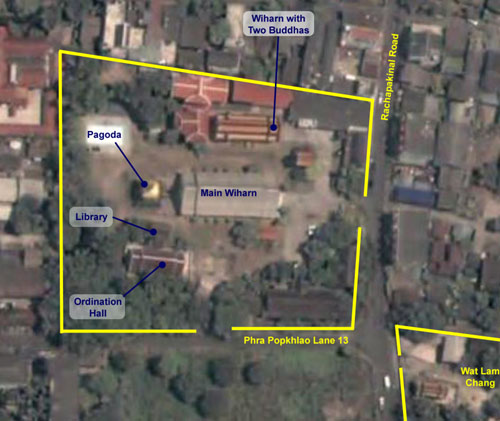Wat Chiang Man
You can take it with you.
Wish you could have this information with you when you visit Chiang Mai? Now you can. Check out our ebook guides.
Wish you could have this information with you when you visit Chiang Mai? Now you can. Check out our ebook guides.
 Located within the walls of the old city, near the Chang Puak gate,
Chiang Man is the oldest temple in Chiang Mai. It was supposedly built
by the founder of the city 700 years ago, King Mengrai, on the spot
where he stayed while planning his new capital. It's a small temple,
and not on the main tourist trail, but it was important for quite some
time.
Located within the walls of the old city, near the Chang Puak gate,
Chiang Man is the oldest temple in Chiang Mai. It was supposedly built
by the founder of the city 700 years ago, King Mengrai, on the spot
where he stayed while planning his new capital. It's a small temple,
and not on the main tourist trail, but it was important for quite some
time. Several small buildings dot the temple compound, and behind the main prayer hall is a chedi.
The base of the pagoda is lined with elephants crafted out of plaster.
All the other buildings are finely decorated in the Northern style,
with red lacquer, gold leaf and many-colored mirrors. Of special
interest is the roof and stairs of the Wiharn to the right of the main chapel which houses two sacred Buddha images. The stair banisters are colorful naga dragons typical of the North. The roof gable-ends also forms beautiful nagas using colored glass and mirror tiles.
Several small buildings dot the temple compound, and behind the main prayer hall is a chedi.
The base of the pagoda is lined with elephants crafted out of plaster.
All the other buildings are finely decorated in the Northern style,
with red lacquer, gold leaf and many-colored mirrors. Of special
interest is the roof and stairs of the Wiharn to the right of the main chapel which houses two sacred Buddha images. The stair banisters are colorful naga dragons typical of the North. The roof gable-ends also forms beautiful nagas using colored glass and mirror tiles.
Plan of Wat Chiang Man
 Window detail on the main prayer hall |
The windows of the main prayer hall are also worth a close look. The frames are tiled with colored mirrors while the shutters for the windows sport gold leaf stencil patterns on both sides of the red lacquer panels.
Beside the pagoda is the temple's library (ho trai), and next to that is the ordination hall (ubosot). The ubosot is usually closed to the public, but on one side of the porch you can see a stone tablet. It dates from the late sixteenth century and recounts the founding of Chiang Mai by King Mengrai in the thirteenth century. There's a copy of the stele in the Chiang Mai Art & Culture Center just a short walk away, near the Three Kings Monument in the
History
Wat Chiang Man was built in 1297 CE as the first temple of Chiang Mai on the location of Wiang Nopburi, a fortified town of the Lawa people which had been used by King Mangrai as a camp during the construction of his new capital city Chiang Mai.[1]Sights
- Chedi Chang Lom - the 'Elephant Chedi' is the oldest construction within the temple complex. The square base supports a second level which has the front half of 15 life-sized brick-and-stucco elephants emerging from it. The elephants seem to carry the upper levels of the building on their backs. The gilded upper part of the chedi contains a bell shaped relic chamber directly underneath the pinnacle.
- Main Wihan - the larger of the two wihans was renovated in the 1920s by the famous monk Khru Ba Srivichai. The building houses a large mondop structure for an altar surrounded by Buddha statues. One of the standing Buddha's has the year 1465 CE engraved on its base, which would make it the oldest statue of the Lanna Kingdom. It is also the oldest statue of Thailand which shows the Buddha with an alms bowl. The façade of the wihan features gilded carvings of Kirthimukha in between flower and plant motives.
- New Wihan - the smaller of the two wihans houses two
important statues of the Buddha which, due to their protective powers,
are regarded as the Palladium statues of Chiang Mai:
- The Phra Sae Tang Khamani is also known as the 'Phra Kaew Khao' or 'Crystal Buddha'. This 10cm tall statue is carved out of a clear quartz crystal. According to Oliver Hargreave[2], the statue was crafted around 200 CE for King Ramraj of Lopburi and brought to the Hariphunchai Kingdom (present day Lamphun) by Queen Jamadevi in 662 CE. It was only transferred to Chiang Mai by King Mangrai in 1296 after he had conquered Lamphun. As it survived the pillaging of that city, the statue is thought to protect against disasters. However, Carol Stratton[3] dates the statue as having been created in the 15th century based on its style characteristics. The gold covered wooden base and golden canopy are later additions donated by King Inthawichayanon of Chiang Mai in 1874. Together they contain more than 6 kg of gold.
- The Phra Sila statue is a stone stele depicting a standing Buddha whilst taming the elephant 'Nalagiri' in bas-relief. It probably originates from Ceylon (present day Sri Lanka) and might date from either the 8th or 10th century CE depending on the source. Due to its alleged rain-giving powers, this statue features prominently during the Songkran festival at the end of the dry season.
- Ubosot - in front of the ubosot one can find a stone stele from the year 1581 CE. This stele contains the oldest mentioning of the founding date of Chiang Mai: the 12th of April, 1296 CE at 4 am. It also mentions that the ubosot was commissioned by King Mangrai and that Phya Saen Luang had it restored in 1571. The present building was built in the 19th century.
- Ho Trai - the Temple Library (scripture depository) of Wat Chiang Man is of a fairly plain design when compared to the Ho Trai belonging to Wat Phra Singh. It is a wooden building set on top of a high plastered brick base. Most temples in Chiang Mai do not feature a Ho Trai.
- Lotus Pond - as with Ho Trai, temple ponds do not feature at most Chiang Mai temples. Both Wat Phra Singh and Wat Chiang Man have one.

Videos
Map
ดูแผนที่ขนาดใหญ่ขึ้น
http://thailandforvisitors.com/north/chiangmai/chiengman/index.html
No comments:
Post a Comment